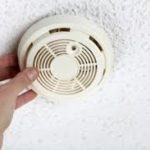 Fire & Rescue NSW (FRNSW) today (Wednesday, 17 January) released the findings of two new research reports to help reduce the number of fatalities in residential fires in NSW. Research was conducted on the effectiveness of sprinklers in residential buildings up to 25 metres in height, as well as the functionality of current residential smoke alarms.
Fire & Rescue NSW (FRNSW) today (Wednesday, 17 January) released the findings of two new research reports to help reduce the number of fatalities in residential fires in NSW. Research was conducted on the effectiveness of sprinklers in residential buildings up to 25 metres in height, as well as the functionality of current residential smoke alarms.
The residential sprinkler research, completed in collaboration with CSIRO, signals the most significant shift in fire safety policy since 2006, when legislation mandated the installation of smoke alarms in all existing homes and shared accommodation.
FRNSW Commissioner and current President of Australasian Fire and Emergency Service Authorities Council (AFAC), Paul Baxter QSO, said FRNSW had undertaken three years of research and testing with the generous support of Fire Protection Association Australia (FPAA), AFAC and CSIRO.
“The results confirm that stronger measures are needed to ensure best practice fire safety and fire prevention in homes,” he said.
“FRNSW has made recommendations from its extensive research into sprinklers and smoke alarms and will be working closely with relevant stakeholders to realise these recommendations over the coming months.”
“To that effect, FRNSW, along with FPAA and AFAC, has submitted a Proposal for Change to the 2019 National Construction Code that seeks to mandate sprinklers in all new Class 2 and Class 3i shared residential accommodation buildings up to 25 metres in effective height.
“Modern-day furnishings and building materials often produce faster fires with higher levels of heat and toxic smoke,” Commissioner Baxter added. “We are committed to keeping the people of NSW fire safe and will continue to carry out research that better informs building code legislation and product standards to improve fire safety.”
Commissioner Baxter said in addition to the requirement of sprinklers in residential buildings, FRNSW is also urging NSW households to increase the number of working alarms in homes to one per bedroom and living space (including hallways and stairways) and to have them interconnected.
“The findings of the smoke alarm research, completed in collaboration with the Australian Building Codes Board (ABCB), reinforces that the number, location and interconnection of working smoke alarms is more important than the type or technology used,” he said.
“On average, there are approximately 21 deaths reported each year as a direct result of residential fires across NSW. Up to a half of those fatalities could have been prevented if these homes had working smoke alarms as well as a home fire escape plan. Additionally, the interconnection of multiple alarms ensures that if one alarm detects smoke, all other alarms will activate to sound a warning.
“Smoke alarms have had a significant impact on reducing the number of fatalities over the past 10 years; however, a combination of fire sprinklers and smoke alarms can significantly further reduce the risk of fatalities in the event of a fire.”
FRNSW encourages all homeowners to adopt best practice fire safety and prevention in their homes to protect themselves and their loved ones from harm, and to protect their property from serious damage.
Fire & Rescue NSW acknowledges and thanks the Commonwealth Scientific and Industrial Research Organisation (CSIRO), Fire Protection Association of Australia (FAA), Australasian Fire and Emergency Service Authorities Council (AFAC) and its member agencies and industry partners for their generous support for its research.
i Class 2 buildings are apartments, home units and flats
ii Class 3 include large boarding houses, guest houses, hostels, backpacker accommodation, residential parts of hotels, motels, schools, health care buildings, detention centres, and certain facilities for aged care, children and people with disabilities.


